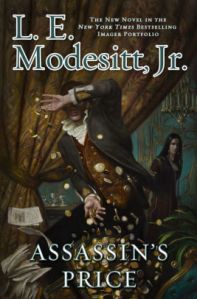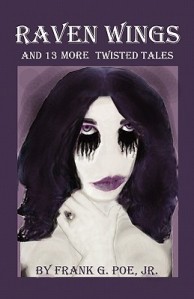 Even today, long after his death, Edgar Allan Poe is recognized as a master of horror and the macabre. A movie’s coming out soon, The Raven, based on his tales & poems, starring John Cusack. Now, a new master of horror has surfaced, a distant relative of Edgar’s: Frank G. Poe, Jr. He may even be, if the stories about him are true, Edgar reincarnated to walk this Earth and write further spellbinding imaginings of the intellect. His first collection of tales, Raven Wings and 13 More Twisted Tales I will also review here, in the coming weeks; but, as Star Child is just out, I will review it first.
Even today, long after his death, Edgar Allan Poe is recognized as a master of horror and the macabre. A movie’s coming out soon, The Raven, based on his tales & poems, starring John Cusack. Now, a new master of horror has surfaced, a distant relative of Edgar’s: Frank G. Poe, Jr. He may even be, if the stories about him are true, Edgar reincarnated to walk this Earth and write further spellbinding imaginings of the intellect. His first collection of tales, Raven Wings and 13 More Twisted Tales I will also review here, in the coming weeks; but, as Star Child is just out, I will review it first.
What can you expect from Star Child? The original Poe’s boots would be difficult for anyone to fil, as any legend is always difficult to live up to and match. I’d say, for starters, don’t expect Edgar’s old-fashioned uses of words that are rapidly fading from general usage. But that’s okay–it certainly worked for Edgar, but it would seem archaic for anyone to try to write mimicking Edgar’s style. If he was reborn, undoubtedly he’d be a man of his times, as he was then, and use current turns of phrases.
Ultimately, Frank G. Poe Jr.’s tales succeed because of his own talent, wherever it might originate from, and he deserves all the credit or blame for however the tales have turned out. But, the good news is, the tales collected in Star Child are very well-written, and I believe Edgar would be proud to know someone in his lineage has taken up the torch and is continuing to attract a wide audience to the horror genre. I can’t do justice to the entire collection by discussing each of the tales in much detail, as that would take at least one paragraph apiece; but, I will touch on a few of the stories that stood out as highlights to me.
I’ll begin from the beginning, with a tale with the very cheery title “Because They Eat Children.” Alexander Popovich is an extremely dedicated and protective fourth grade teacher, who gets a bit carried away with thinking he needs to watch over his young flock. He tells them anecdotes of children being eaten by evil people, and even by their own parents, in times of dire famine, or because they have developed a perverse taste for human flesh. He means only to make the children aware of the dangerous world around them so they can better be on guard. But, word gets back to the parents of the children, and things start to go very downhill for Alexander from there on. If only poor Alexander was taken more seriously…but why cry over spilt blood?
The second story is an homage to The Lord of the Rings. “Tolkien Revisited,” shows Poe’s interest in and love of Tolkien’s Lord of the Rings novels. In the tale, Frodo, Gandalf, and the rest of the band stop at a roadside inn on their way home from their adventures and the destruction of the ring. They relate their adventures to the innkeeper, who happens to be Tolkien. The innkeeper thinks he can spice their story up, and he invents new characters, such as Gollum/Smeagle, and he changes/adds details. When he tells the new version back to the adventurers, they are spellbound–indeed, the innkeeper has vastly improved the tale. But, at what cost?
“The Blue Knight’s Tale,” is the third tale of the collection.
It’s a story of modern-day knights, jousting on a–ahem–nightly basis at a Medieval Tournament and Feast resaurant. There is, of course, a Lady Fair, as well, Kitty. She is engaged to be married to the Black Knight, her current boyfriend, Stephen. Austin, the Blue Knight, used to have a “puppy love,” for Kitty, but that ended badly after their senior prom. Still retaining his boyishly good looks, Austin has recovered from his puppy love, with semingly every female in the audience anxious to make him their next mark on their lipstick cases. Or, has he fully recovered? What happens when their old romantic is rekindled? Find out the shattering result when you check the story out for yourselves!
Before I mention a couple of other tales, I would be remiss if I didn’t relate that Frank, like Edgar, writes poetry as well as short stories. He has three poems in the collection “Holocaust,” “Melancholy and the Internet Madness,” and “Contact.” “Holocaust,” is, as you’ve likely guessed (being the astute people that you are), about the Holocaust and our reactions to it, including those of naysayers. The second poem, “Melancholy and the Internet Madness,” is about the obsession of many people with the Internet in general and social media in particular. One begins to feel sometimes filled with a self-importance based on Likes, Follows, etc., that is unrealistic. The obsession is like a form of madness at times. Finally, “Contact,” is about Stephen Hawkings and his fear that our first contact with aliens might well prove to be our last. Poe has a very different take on the ensuing result, though, in the last of a very imaginative and thought-provoking trio of poems.
I’ll briefly mention two of the other tales in Star Child to give you a further taste of the menage of genres and stories that await you. These two tales are the title one, “Star Child The Discovery,” and “After the Apocalypse.”
“Star Child” is another foray into the science fiction genre by Frank, and it’s an engrossing and brilliant gem of a short story. An artifact from an alien civilization is discovered–and, though the dig team is sworn to secrecy by the federal government, they feel that the information they’ve discovered is too important for the public to not learn about. But, they also don’t want to get into legal trouble, so they decide to make a “fictional” account of the whole story available to everyone and the names of those involved will be changed. Though it’s walking a fine line, they feel it’s worth the potential risk. But, is it, really; and, will the public even benefit at all from what they read, if they believe it to be fictional?
The last tale I’ll discuss is “After the Apocalypse.” Based in part from an old Appalachian saying, “Root hog or die,” this is one of my favorite (of many) in Frank G. Poe Jr.’s collection. Then again, how could I NOT like it, as one of the main characters is named Lilly, which is our family “dog’s” name, though ours is spelled with only two l’s? Lilly’s Granny Sugar is the propagator of the saying, and living through the Great Depression as she did, she demanded her daughter, Rose, to learn survival skills from childhood on. Lilly compares this brutal sort of existence to the scenario of Lord of the Flies, and there is at least some truth to that. Since Granny Sugar comes from Pike County, Kentucky, where the McCoy clan (of the infamous Hatfield/McCoy feud) lived, it’s not much of a wonder that she believed in the philosophy of: “When society breaks down only the strong survive, root hog or die.”
This and some of the other tales, though they’re fascinating reading, contain some language that makes the collection more suitable for older teens and adults than younger children. I suspect that back in the time when Edgar wrote his poems and stories, many people found them morally offensive, as well, though now they’re generally considered to be fairly tame in comparison with even what children see on the Nightly News. Perhaps this collection will porve to seem tame to future generations. Don’t get me wrong; Poe is never explicit, and he only uses adult language at times because it’s warranted by the subject matter of his tales and to make the characters who speak the words more realistic. Right or wrong, most of us use four-letter words on a daily basis, so I, personally, wasn’t offended at all by any of the tales in Star Child.
If you are a fan of Edgar Allan Poe, Stephen King, or Frank G. Poe’s first collection of macabre tales, Star Child is a Must Read! And, if you love the horror, fantasy, and SF genres, I would also recommend this fine selection of quirky tales to you. I look forward with great anticipation to reading more from Frank in the coming years, and to reviewing his first collection in a couple of weeks or so.
Share this: What's New In Book Reviews
 Assassin’s Price by L.E. Modesitt, Jr. is the latest and eleventh novel in his bestselling Imager Portfolio series. Like all the other books in the series, Assassin’s Price is set in a world where magic is the literal realization of the imagination. Rex Lorien is back, though six years older than he was in the last book of the series, Treachery’s Tools from 2016. In this novel, more focus is on his eldest son, Charyn, and his attempts to learn more about Solidar and the economics of it, in order to better be prepared one day to take over from his father as the ruler. You can WIN a hardback copy of this page-turning, adventure-filled addition to the series if you are a resident of the United States of Canada and leave a non-Spam related comment below, saying what your name is and where you live, the state or province, to verify that you are eligible to enter! You also must be 18 years or older, and a few other rules are below. Daily entries are allowed.
Assassin’s Price by L.E. Modesitt, Jr. is the latest and eleventh novel in his bestselling Imager Portfolio series. Like all the other books in the series, Assassin’s Price is set in a world where magic is the literal realization of the imagination. Rex Lorien is back, though six years older than he was in the last book of the series, Treachery’s Tools from 2016. In this novel, more focus is on his eldest son, Charyn, and his attempts to learn more about Solidar and the economics of it, in order to better be prepared one day to take over from his father as the ruler. You can WIN a hardback copy of this page-turning, adventure-filled addition to the series if you are a resident of the United States of Canada and leave a non-Spam related comment below, saying what your name is and where you live, the state or province, to verify that you are eligible to enter! You also must be 18 years or older, and a few other rules are below. Daily entries are allowed.







